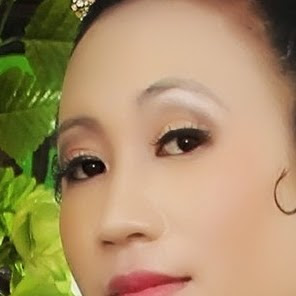In one form or another, batik has worldwide popularity. Now, not only is batik used as a material to clothe the human body, its uses also include furnishing fabrics, heavy canvas wall hangings, tablecloths and household accessories. Batik techniques are used by famous artists to create batik paintings, which grace many homes and offices.
The Javanese aristocrats R.A. Kartini in kebaya and her husband. Her skirt is of batik, with the parang pattern, which was for aristocrats. Her husband is wearing a blangkon
Depending on the quality of the art work, dyes, and fabric, the finest batik tulis halus cloth can fetch several thousand dollars and it probably took several months to make. Batik tulis has both sides of the cloth ornamented.
In Indonesia, traditionally, batik was sold in 2.25-meter lengths used for kain panjang or sarong for kebaya dress. It can also be worn by wrapping it around the body, or made into a hat known as blangkon. Infants are carried in batik slings decorated with symbols designed to bring the child luck. Certain batik designs are reserved for brides and bridegrooms, as well as their families. The dead are shrouded in funerary batik. Other designs are reserved for the Sultan and his family or their attendants. A person’s rank could be determined by the pattern of the batik he or she wore.
For special occasions, batik was formerly decorated with gold leaf or dust. This cloth is known as prada (a Javanese word for gold) cloth. Gold decorated cloth is still made today; however, gold paint has replaced gold dust and leaf.
Batik garments play a central role in certain rituals, such as the ceremonial casting of royal batik into a volcano. In the Javanese naloni mitoni “first pregnancy” ceremony, the mother-to-be is wrapped in seven layers of batik, wishing her good things. Batik is also prominent in the tedak siten ceremony when a child touches the earth for the first time. Batik is also part of the labuhan ceremony when people gather at a beach to throw their problems away into the sea.
The wide diversity of patterns reflects a variety of influences, ranging from indigenous designs, Arabic calligraphy, European bouquets and Chinese phoenixes to Japanese cherry blossoms and Indian or Persian peacocks.
Contemporary men batik shirt in typical Solo style, sogan color and lereng motif.
Contemporary batik, while owing much to the past, is markedly different from the more traditional and formal styles. For example, the artist may use etching, discharge dyeing, stencils, different tools for waxing and dyeing, or wax recipes with different resist values. They may work with silk, cotton, wool, leather, paper, or even wood and ceramics.
The Javanese aristocrats R.A. Kartini in kebaya and her husband. Her skirt is of batik, with the parang pattern, which was for aristocrats. Her husband is wearing a blangkon
Depending on the quality of the art work, dyes, and fabric, the finest batik tulis halus cloth can fetch several thousand dollars and it probably took several months to make. Batik tulis has both sides of the cloth ornamented.
In Indonesia, traditionally, batik was sold in 2.25-meter lengths used for kain panjang or sarong for kebaya dress. It can also be worn by wrapping it around the body, or made into a hat known as blangkon. Infants are carried in batik slings decorated with symbols designed to bring the child luck. Certain batik designs are reserved for brides and bridegrooms, as well as their families. The dead are shrouded in funerary batik. Other designs are reserved for the Sultan and his family or their attendants. A person’s rank could be determined by the pattern of the batik he or she wore.
For special occasions, batik was formerly decorated with gold leaf or dust. This cloth is known as prada (a Javanese word for gold) cloth. Gold decorated cloth is still made today; however, gold paint has replaced gold dust and leaf.
Batik garments play a central role in certain rituals, such as the ceremonial casting of royal batik into a volcano. In the Javanese naloni mitoni “first pregnancy” ceremony, the mother-to-be is wrapped in seven layers of batik, wishing her good things. Batik is also prominent in the tedak siten ceremony when a child touches the earth for the first time. Batik is also part of the labuhan ceremony when people gather at a beach to throw their problems away into the sea.
The wide diversity of patterns reflects a variety of influences, ranging from indigenous designs, Arabic calligraphy, European bouquets and Chinese phoenixes to Japanese cherry blossoms and Indian or Persian peacocks.
Contemporary men batik shirt in typical Solo style, sogan color and lereng motif.
Contemporary batik, while owing much to the past, is markedly different from the more traditional and formal styles. For example, the artist may use etching, discharge dyeing, stencils, different tools for waxing and dyeing, or wax recipes with different resist values. They may work with silk, cotton, wool, leather, paper, or even wood and ceramics.
Ditulis Oleh Haryanto AgS : Unknown ~ Aneka Info, Software, Blogging, Kesehatan, Games, Driver Laptop, Mp3, Movie
 Anda sedang membaca artikel tentang Batik Culture. Anda diperbolehkan mengcopy paste atau menyebar-luaskan artikel ini, namun jangan lupa untuk meletakkan link dibawah ini sebagai sumbernya. Saling menghargai kreatifitas Sesama Blogger. Ok
Anda sedang membaca artikel tentang Batik Culture. Anda diperbolehkan mengcopy paste atau menyebar-luaskan artikel ini, namun jangan lupa untuk meletakkan link dibawah ini sebagai sumbernya. Saling menghargai kreatifitas Sesama Blogger. Ok



No comments:
Post a Comment